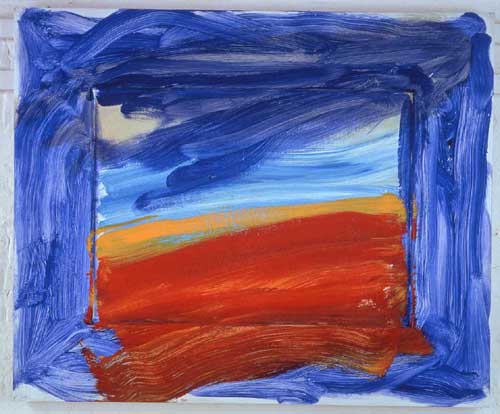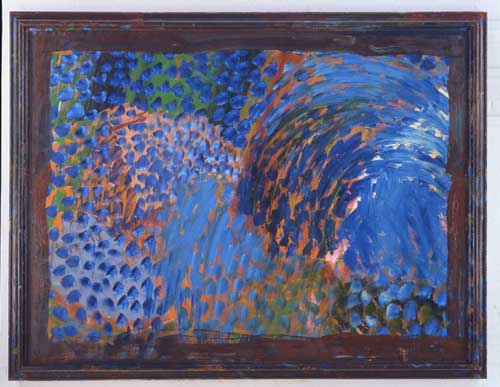

August-October 2002, Dean Gallery, Edinburgh
Scale is a central issue with Hodgkin. I remember visiting his last exhibition in Edinburgh and meeting the artist, in December 1990. The exhibition, a British Council Travelling Exhibition then, was Small Paintings 1975-1989. This year's show was Large Paintings 1984-2002. It consisted of 20 large paintings produced over two decades.
Paintings such as Italy were only recently completed and were shown in Edinburgh for the first time. A small catalogue with excellent essays by Robert Rosenblum accompanies the show. Director of the Scottish National Gallery of Modern Art, Richard Calvocoressi points out that while Hodgkin's pictures are immediately recognisable, they do not hang easily together. The exhibition of small paintings in 1990 was hung so that each painting had its own wall thus enabling it to be viewed in a self-contained situation. In the summer exhibition the walls were painted a dark colour to create a space that is 'more amorphous, less immediately defined'. Regarding the question of scale, Calvocoressi notes, 'With small paintings he does not have to worry so much about the picture surface. "It's easy to make a window, a hole in the wall, into which the viewer can look". With large, human-scale paintings, Hodgkin is still trying to give the illusion of "a space that is a box - a notional interior", but he also feels it is vital to manipulate the picture surface and the architecture of the painting in such a way that the viewer can relate to it piecemeal as well as seeing the whole thing'.1
Hodgkin admits to only being able to manage a large picture space in the past ten years or so, 'You have to keep the picture surface alive "all over", in a way that you don't with smaller paintings. You can't pretend the picture surface isn't there on a large scale'.2 Hodgkin's working methods are not typical. The painting Lovers (finished in 1992) took eight years to complete. He works out many aspects of a large painting in his mind - there are few preliminary works, few props or aide-memoire. Hodgkin works in an all-white studio without windows or a live model. He carries with him an extensive knowledge of other artists' work. He believes that the media-dominated culture in which we live is prompting a return to the lasting values of painting.
'Working from his memory and imagination, he makes images evoking the transitoriness of life, in which forms are ambiguous, blurred, disintegrating. While the source for this may be autobiographical, private feelings are transmuted into archetypal pictorial statements through the impersonality of the artist's marks and brushstrokes.'3
A characteristic of Howard Hodgkin's work is the fact that the painting is extended onto the frame, 'these frames seem to compress and intensify the pictorial drama within their boundaries. The drama, in fact, is almost literal, since the frames immediately set up theatrical expectations, like prosceniums behind which events or emotions unfold. And the play performed before our eyes is always so alive, so startlingly present that these fictional frames seem to respond in turn. Both inner and outer edges blur and heave, merging with what is taking place on Hodgkin's pictorial stage, elusive images of encounters and memories, both passionate and gentle, whose potency can dissolve any efforts to fix them forever in a rectangular box'.4
The interaction between canvas and frame continues the dialogue within time. Created over a long period, Hodgkin's pictures reflect 'the flux of life and memory'. The remembrance of things past - a Proustian experience is here created in visual terms supported notionally by titles such as Rain, Memories or Italy, or Sunday in Berlin or Memories of Max. It is difficult to imagine how Hodgkin can allude to a particular Sunday in Berlin over four years; the juxtaposition of specific personal images, formal painterly considerations, fleeting moments. Rosenblum describes it beautifully, 'Their intimacy and their focus on fleeting experiences remembered are basic to their visual drama. We are in the world of diary rather than a full-length autobiography, of a short story rather than a novel … The heaviness and width of Hodgkin's fictional frames contribute to the intensity of his psychological chamber music, distilling the paths of emotions into ever smaller spaces, like boxes within boxes. And the frames also distance the drama from the spectator, as if the realm of memory were seen through a reducing glass.'5
Hodgkin's abstract paintings evoke themes such as sexuality, loss and memory. Specific places are alluded to, moments of passion evoked. Colour is used powerfully and economically. The effect of dramatic weather is created, recalling the marvellous effects of Constable and Turner. An ancestor of Hodgkin was Luke Howard who, 'in the early 19th century, pioneered the science of meteorology, classifying and naming cloud patterns in publications that triggered the poetic imagination of Constable and his compatriots as well as of many Romantic landscape painters on the Continent'.6
British weather for all its gloom and unpredictability is a constant source of inspiration to Hodgkin who merges physical phenomena and psychological experience, for example, Rain and Hope. Turner has been a great inspiration for Hodgkin whose fluid painterliness evokes emotional states. Hodgkin's work displays many influences, not only British. In 2000, the National Gallery, London organised their millennium exhibition around the dialogue between contemporary art and the art of the past, using works from their famous collection. Some 24 artists were chosen for Encounters: New Art from Old. Hodgkin chose Seurat's, Bathers at Asnières, producing a dramatic and remarkable interpretation which was included in the Edinburgh exhibition this summer. Rosenblum describes the process in this way, 'The result, almost as imposingly large as Seurat's own mural-sized painting, seems to transform public into private, as if the old-master's stately, immobile structure had dissolved in memory and we were looking instead at an image fading away behind closed eyes'.7
Hodgkin's vision is in fact closer to the private world of Vuillard or Bonnard. The glowing, seductive interiors, masterfully constructed in formal terms, and which so transfix the viewer's attention, share something of Hodgkin's private, glowing worlds. Howard Hodgkin departs from his nineteenth century mentors in his use of dramatic colour, that owe more to the Abstract Expressionists such as Willem De Kooning or Marc Rothko. Hodgkin visited New York in 1948 where he saw the early work of these and other American artists. In London, in 1959, he saw the pivotal exhibition The New American Painting, which influenced many British artists at the time (See Ceri Richards review). Richard Kendall refers to Hodgkin's 'reckless generosity'8 in paint. Rosenblum concludes his fine essay, 'Always stamped with his unique presence, his art offers an unfamiliar, but unforgettable marriage of the abstract and the earthbound, of rhapsodic visual pleasures and quiet memories of a life lived outside the studio walls'.9
1 Richard Calvocoressi, "Introduction", Howard Hodgkin, Large Paintings, 1984-2002, National Galleries of Scotland, Edinburgh, 2002, p.10.
2 Hodgkin quoted ibid, p.10.
3 Calvocoressi, ibid, p.10.
4 Robert Rosenblum, "On Howard Hodgkin", ibid, p.13.
5 Ibid, p.14.
6 Ibid, p.15.
7 Ibid, p.17.
8 Richard Kendall, "Panel Discussions: Howard Hodgkin's Large Paintings", ibid, p.29.
9 Rosenblum, ibid, p.19.

